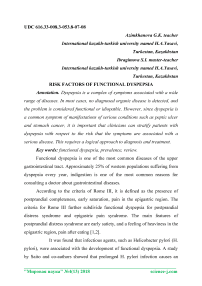Risk factors of functional dyspepsia
Автор: Azimkhanova G.K., Ibragimova S.I.
Журнал: Мировая наука @science-j
Рубрика: Естественные и технические науки
Статья в выпуске: 4 (13), 2018 года.
Бесплатный доступ
Dyspepsia is a complex of symptoms associated with a wide range of diseases. In most cases, no diagnosed organic disease is detected, and the problem is considered functional or idiopathic. However, since dyspepsia is a common symptom of manifestations of serious conditions such as peptic ulcer and stomach cancer, it is important that clinicians can stratify patients with dyspepsia with respect to the risk that the symptoms are associated with a serious disease. This requires a logical approach to diagnosis and treatment.
Functional dyspepsia, prevalence, review
Короткий адрес: https://sciup.org/140263469
IDR: 140263469
Текст научной статьи Risk factors of functional dyspepsia
Functional dyspepsia is one of the most common diseases of the upper gastrointestinal tract. Approximately 25% of western populations suffering from dyspepsia every year, indigestion is one of the most common reasons for consulting a doctor about gastrointestinal diseases.
According to the criteria of Rome III, it is defined as the presence of postprandial completeness, early saturation, pain in the epigastric region. The criteria for Rome III further subdivide functional dyspepsia for postprandial distress syndrome and epigastric pain syndrome. The main features of postprandial distress syndrome are early satiety, and a feeling of heaviness in the epigastric region, pain after eating [1,2].
It was found that infectious agents, such as Helicobacter pylori (H. pylori), were associated with the development of functional dyspepsia. A study by Saito and co-authors showed that prolonged H. pylori infection causes an increase in the thickness of the muscular layer of the stomach, which leads to an accelerated gastric emptying. To investigate the pathogenesis of this process, they analyzed the expression profile of micro RNA in the stomach of infected mice. MicroRNAs are small non-coding RNAs that function as endogenous silencing of target genes, thereby playing an important role in cell proliferation, apoptosis, and differentiation. Saito and his colleagues found a significant decrease in the activity of microRNA-1 and miRNA-133 in the muscle layer as a result of a prolonged H. pylori infection. Thus, the authors suggest that a decrease in the function of microRNA can cause hyperplasia of the muscular layer, which leads to accelerated gastric emptying and development of dyspeptic symptoms [3,4].
Double-blind randomized controlled studies investigating the effects of H. pylori eradication in humans have produced conflicting results. Although Miwa and co-authors report that there is no benefit from destroying H. pylori infection for the treatment of functional dyspepsia, another study among the Asian population has shown improvement in symptoms. But, histological studies showed no correlation between the severity of inflammation and the presence of dyspepsia [5,6,7].
Visceral hypersensitivity is also associated with the development of functional dyspepsia. In particular, the stomach's hypersensitivity was caused by several different factors. It has been shown that hypersensitivity is associated with gastric distension, gastric acid and bile. Studies have shown that patients with functional dyspepsia, especially those who complain of postprandial epigastric pain, experience pain at a lower gastric acidity level, it is suggested that increased sensitivity to mechanical stretching can be a source of epigastric discomfort [8].
In addition, it was shown that the level of gastric acid secretion in patients with functional dyspepsia does not increase, but there is hypersensitivity to the mucous membrane of the duodenum to normal gastric acid [5].
Along with this, it is assumed that hypersensitivity is perceived at the central sensory level, while glutamate is considered as a potential neurotransmitter. This theory suggests that an increase in the presynaptic release of glutamate in the central sensory regions facilitates the transmission of visceral sensory signals, which leads to an increased response to stimuli and pain perception. In addition, patients with functional dyspepsia underwent functional imaging studies and found abnormal regional cerebral activity in these patients, which indicates the effect of the central nervous system [9].
Список литературы Risk factors of functional dyspepsia
- Lissauer T., Kleyden G. Propedevtika detskikh bolezney, illyustrirovannyy uchebnik/ per. s angl. pod red. N.A.Geppe. - 3-ye izd. - M., 2008.
- Geppe N.A. Propedevtika detskikh bolezney: uchebnik + SD.-M., 2008.
- Dore M.P., Pes G.M., Bassotti G. BMJ 2001. Dyspepsia: When and How to Test for Helicobacter pylori Infection.
- Usai-Satta P. BMJ. 2011. Anorexia, nausea, vomiting, and pain
- Chernecky CC, Berger BJ 2008. Laboratory Tests and Diagnostic Procedures, 5th ed. St. Louis: Saunders.
- Fischbach FT, Dunning MB III, eds. 2009. Manual of Laboratory and Diagnostic Tests, 8th ed. Philadelphia: Lippincott Williams and Wilkins.
- Pagana KD, Pagana TJ 2010. Mosby’s Manual of Diagnostic and Laboratory Tests, 4th ed. St. Louis: Mosby Elsevier.
- Fischbach FT, Dunning MB III, eds. 2009. Manual of Laboratory and Diagnostic Tests, 8th ed. Philadelphia: Lippincott Williams and Wilkins. Abdelshaheed NN, Goldberg DM. Crit Rev Clin Lab Sci. 1997. Biochemical tests in diseases of the intestinal tract: their contributions to diagnosis, management, and understanding the pathophysiology of specific disease states.
- Ned Tijdschr Geneeskd. 1951. Examination of the duodenal contents.


